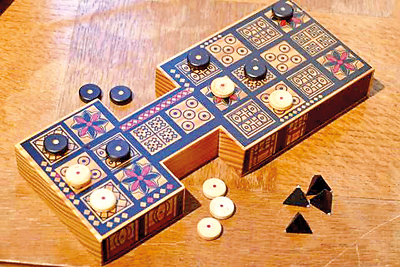Vanishing Avurudu board games
 K. K. Gunatilleke from Bentota recalls a time when Avurudu was never complete without a wooden game board or two on the isthoppu (verandah) or the meda midula (inner courtyard)- strewn with coconut shells, cowries and pretty olinda seeds. It was all part of the festive air- alongside the petti full of kevun, kokis, weli thalapa, peni walalu and aasmi and the raban playing and crackers.
K. K. Gunatilleke from Bentota recalls a time when Avurudu was never complete without a wooden game board or two on the isthoppu (verandah) or the meda midula (inner courtyard)- strewn with coconut shells, cowries and pretty olinda seeds. It was all part of the festive air- alongside the petti full of kevun, kokis, weli thalapa, peni walalu and aasmi and the raban playing and crackers.
Board games were for children and women mostly, he says, though the men probably had a toss when they felt like it.
Chief among these games was Olinda Keliya. The old kavi have it that the game came from Bangladesh (Bangali-dese). Its origins anyway are from the Indian subcontinent- because both Olinda and Pancha are games to placate goddess Pattini- a deity who watches over women and children.
 When King Gajaba brought over the bangle of goddess Pattini from the Chola country in the 2nd Century, both Pancha and Olinda must have come over.
When King Gajaba brought over the bangle of goddess Pattini from the Chola country in the 2nd Century, both Pancha and Olinda must have come over.
Olinda is played on a kolombuwa or a wooden board often made of a costly wood- ebony, sandalwood, jak, satinwood, nadun or milla. It is treasured- kept reverently on the highest shelf of an almirah and taken out on a ‘good’ day as April draws near.
The kolombuwa is kept away from direct sunlight and never placed on sandy ground- marks of respect for its close association with Pattini.
Fifty six of the polished scarlet Olinda seeds with a black eye are needed- called Crab’s eye in English or Jequirity, Rosary Pea or Indian licorice.
The board has nine holes on either side and four seeds go into each hole. The players have to shift the seeds from one hole to the other and collect the seeds found in the hole immediately after an empty one. Ultimately the player who could collect the largest amount of olinda seeds becomes the winner of the game.
While the two players are thus employed the others sing olinda kavi. The princesses of Kandy and older kingdoms, it is said, played olinda with real pearls.
Pancha was a similar game played using cowries. Sumana Yapa, from Weligama, remembers playing pancha with neighbours and relatives on those long April afternoons.
She recalls that, when the game was played near the paddy fields, it was always someone with ‘lucky’ hands or pregnant or lactating women who inevitably made the first moves.
Also dedicated to Pattini, the players offered ‘panduru’ or coins before playing and a visit to a Pattini shrine after Avurudu is over is imperative- when more offerings are made.
The petha or the board for pancha resembles a ludo board. It could be drawn on a thin board or even the ground.
Five cowries, a coconut shell and game pieces are required.
The cowries are thrown on top of the shell and points given according to how the cowries land.
The Tamil influence is apparent as number one is called ‘ondu’, two is ‘rendu’ and five ‘pancha’.
If all cowries land facing upward the position is called Sirimale and the player cannot proceed. If all cowries land downward the position is bokka and the player is given another chance.
According to the number of shells that fall upward the player can move his piece forward. If an opponent’s piece lands on the square with your piece or passes your piece, you return to the starting line. If you are on a crossed out square called a gey, you do not return to the square one. The goal is to get all your pieces to the end before the opponent.
The pieces, Sumana says, were small wooden chips called ‘ballo’. The final square is called ‘jalaya’, and to pass Jalaya one must have a ‘pancha’ or all five cowries upturned. Once each balla passes Jalaya, it is ‘crowned’ and to have all ballo crowned is the goal.
Nerenchi- now less common- was another favourite in the past. This is a variation of Twelve Men’s Morris which pops up across the world in a medley of avatars- with the same basics as Draughts.



